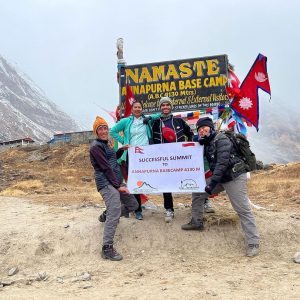Overview of the Annapurna Base Camp Trek: A Himalayan Adventure
Nestled amidst the majestic peaks of the Annapurna range in the Himalayas, the Annapurna Base Camp trek is a trekker’s paradise that unfolds a mesmerizing tapestry of landscapes, diverse cultures, and awe-inspiring vistas. This overview provides a glimpse into the essence of this iconic trek, encompassing its route, highlights, challenges, and the unparalleled experience it offers.
1. Route and Itinerary: The Annapurna Base Camp trek typically spans around 10 to 14 days, depending on the chosen route and acclimatization needs. Starting from Nayapul, the trail winds through charming Gurung villages, lush rhododendron forests, and terraced fields. Key waypoints include Ghorepani, Poon Hill, Chhomrong, and Machapuchare Base Camp before reaching the ultimate destination, Annapurna Base Camp, at an elevation of 4,130 meters (13,549 feet).
2. Natural Wonders: The trek takes trekkers through a kaleidoscope of natural wonders. The lush forests in the lower regions give way to alpine meadows adorned with blooming rhododendrons during spring. As trekkers ascend, the landscape transforms into a rugged terrain surrounded by snow-capped peaks, with panoramic views of Annapurna South, Hiunchuli, Machapuchare, and others creating a breathtaking spectacle.
3. Cultural Encounters: The trek is not just a visual feast but a cultural odyssey as well. Passing through traditional Gurung and Magar villages, trekkers get a glimpse into the daily lives and customs of the locals. Warm hospitality, traditional architecture, and encounters with local flora and fauna enrich the cultural experience along the trail.
4. Challenges and Preparations: While the Annapurna Base Camp trek is considered moderate in terms of difficulty, it presents challenges that require physical fitness and mental resilience. Altitude acclimatization is crucial, and trekkers should be prepared for variable weather conditions, especially in higher altitudes. Adequate preparation, including cardiovascular training and proper gear, is essential for a successful and enjoyable trek.
5. Culmination at Annapurna Base Camp: The climax of the trek is the arrival at Annapurna Base Camp. Situated amidst a natural amphitheater of towering peaks, this location offers a surreal panorama. The sense of accomplishment and the overwhelming beauty of the surroundings make the journey truly rewarding.
The Annapurna Base Camp trek is not just a trek; it’s an expedition through diverse ecosystems, cultures, and elevations. With its ever-changing scenery, welcoming communities, and awe-inspiring vistas, this trek is a testament to the wonders of the Himalayas and an experience that stays etched in the memories of those who venture into its heart.

Best Time For Annapurna Base Camp Trek:
Embarking on the Annapurna Base Camp trek is a dream for many adventure seekers, and choosing the right time to undertake this journey can significantly enhance your experience. In this blog post, we will delve into the intricacies of the best time to trek to the Annapurna Base Camp, focusing on the magical seasons of spring and autumn.
Spring (March to May):
Spring in the Annapurna region is a symphony of colors and pleasant weather. As the snow begins to melt, the trails come alive with a burst of rhododendron blossoms, painting the landscape with vibrant hues of red, pink, and white. The temperatures during spring are mild, ranging from 10 to 20 degrees Celsius (50 to 68 degrees Fahrenheit), making it an ideal time for trekking.
The clear skies and longer daylight hours provide trekkers with ample opportunities to absorb the breathtaking surroundings. The crisp air enhances visibility, offering unobstructed views of the Annapurna massif and other neighboring peaks. The trails are generally dry, and the chances of rain are minimal, ensuring a stable and enjoyable trekking experience.
Autumn (September to November):
Autumn is another prime season for the Annapurna Base Camp trek, attracting trekkers with its clear skies, stable weather, and cultural festivities. Following the monsoon season, the air is crisp, and the landscapes are rejuvenated. The temperatures range from 10 to 20 degrees Celsius (50 to 68 degrees Fahrenheit), creating comfortable trekking conditions.
The trails are dry, providing a stable footing, and the visibility is excellent, allowing trekkers to relish panoramic views of the surrounding peaks. Autumn is also a time of celebration in the region, with various cultural festivals adding a vibrant touch to the trekking experience. Engaging with the local communities during these festivities provides a deeper understanding of the rich Himalayan culture.
Considerations for a Seamless Trek:
To ensure a seamless and enjoyable Annapurna Base Camp trek, consider the following factors:
- Tea House Availability: Confirm the operational status of tea houses along the route, especially in the early and late stages of the trekking seasons.
- Crowd Levels: Spring and autumn are popular trekking seasons, attracting a higher number of adventurers. If you prefer a more solitary experience, plan your trek at the beginning or end of these seasons.
- Weather Variability: While spring and autumn generally offer stable weather conditions, be prepared for occasional variations. Carrying suitable layers and equipment for sudden weather changes is advisable.
Embarking on the Annapurna Base Camp trek is a dream for many adventure seekers, and choosing the right time to undertake this journey can significantly enhance your experience. In this blog post, we will delve into the intricacies of the best time to trek to the Annapurna Base Camp, focusing on the magical seasons of spring and autumn.
The trails are dry, providing a stable footing, and the visibility is excellent, allowing trekkers to relish panoramic views of the surrounding peaks. Autumn is also a time of celebration in the region, with various cultural festivals adding a vibrant touch to the trekking experience. Engaging with the local communities during these festivities provides a deeper understanding of the rich Himalayan culture.
Considerations for a Seamless Trek: To ensure a seamless and enjoyable Annapurna Base Camp trek, consider the following factors:
- Tea House Availability: Confirm the operational status of tea houses along the route, especially in the early and late stages of the trekking seasons.
- Crowd Levels: Spring and autumn are popular trekking seasons, attracting a higher number of adventurers. If you prefer a more solitary experience, plan your trek at the beginning or end of these seasons.
- Weather Variability: While spring and autumn generally offer stable weather conditions, be prepared for occasional variations. Carrying suitable layers and equipment for sudden weather changes is advisable.
Conclusion: Embarking on the Annapurna Base Camp trek during the enchanting seasons of spring or autumn promises a visual feast and a culturally enriching experience. Whether you choose to witness the rhododendron bloom in spring or the clear mountain vistas in autumn, careful planning and preparation will ensure that your trek becomes an unforgettable adventure in the heart of the Himalayas.
Website : Base Camp Trip



Comment (0)